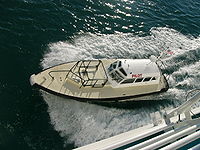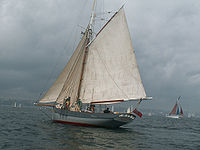
Pilot boat
Encyclopedia

History

Latin
Latin is an Italic language originally spoken in Latium and Ancient Rome. It, along with most European languages, is a descendant of the ancient Proto-Indo-European language. Although it is considered a dead language, a number of scholars and members of the Christian clergy speak it fluently, and...
word pilota, a variation of pedota, the plural of pēdón which translates as oar
Oar
An oar is an implement used for water-borne propulsion. Oars have a flat blade at one end. Oarsmen grasp the oar at the other end. The difference between oars and paddles are that paddles are held by the paddler, and are not connected with the vessel. Oars generally are connected to the vessel by...
. There is also evidence the word pylotte was also used, again a variation from pedota. The word originated from around 1520-1530.
However, the work functions of the pilot go back to Ancient Greece
Ancient Greece
Ancient Greece is a civilization belonging to a period of Greek history that lasted from the Archaic period of the 8th to 6th centuries BC to the end of antiquity. Immediately following this period was the beginning of the Early Middle Ages and the Byzantine era. Included in Ancient Greece is the...
and Roman
Ancient Rome
Ancient Rome was a thriving civilization that grew on the Italian Peninsula as early as the 8th century BC. Located along the Mediterranean Sea and centered on the city of Rome, it expanded to one of the largest empires in the ancient world....
times, when locally experienced harbour captains, mainly local fishermen, were employed by incoming ships captains to safely bring into port their trading vessels. Eventually, in light of the need to regulate the act of pilotage and ensure pilots had adequate insurance, the harbours themselves licensed pilots for each harbour.
Although licensed by the harbour to operate within their jurisdiction, pilots were generally self-employed, meaning that they had to have quick transport to get them from the port to the incoming ships. As pilots were often still dual-employed, they hence used their own fishing boats to reach the incoming vessels. But fishing boats were heavy working boats, and filled with fishing equipment, and so hence a new type of boat was required.
Early boats were developed from single masted cutters and twin masted yawl
Yawl
A yawl is a two-masted sailing craft similar to a sloop or cutter but with an additional mast located well aft of the main mast, often right on the transom, specifically aft of the rudder post. A yawl (from Dutch Jol) is a two-masted sailing craft similar to a sloop or cutter but with an...
s, and latterly into the specialist pilot cutter. These were effectively light-weigh and over powered single masted boats with large steeply angled keels, making them deep draft
Draft (hull)
The draft of a ship's hull is the vertical distance between the waterline and the bottom of the hull , with the thickness of the hull included; in the case of not being included the draft outline would be obtained...
under power and shallow draft in lighter sail.
If legend is to believed the first official Bristol Channel
Bristol Channel
The Bristol Channel is a major inlet in the island of Great Britain, separating South Wales from Devon and Somerset in South West England. It extends from the lower estuary of the River Severn to the North Atlantic Ocean...
pilot was barge master George James Ray, appointed by the Corporation of Bristol in May 1497 to pilot John Cabot
John Cabot
John Cabot was an Italian navigator and explorer whose 1497 discovery of parts of North America is commonly held to have been the first European encounter with the continent of North America since the Norse Vikings in the eleventh century...
's Matthew
Matthew (ship)
The Matthew was a caravel sailed by John Cabot in 1497 from Bristol to North America, presumably Newfoundland. After a voyage which had got no further than Iceland, Cabot left again with only one vessel, the Matthew, a small ship , but fast and able. The crew consisted of only 18 people. The...
from Bristol harbour
Bristol Harbour
Bristol Harbour is the harbour in the city of Bristol, England. The harbour covers an area of . It has existed since the 13th century but was developed into its current form in the early 19th century by installing lock gates on a tidal stretch of the River Avon in the centre of the city and...
to the open sea beyond the Bristol channel
Bristol Channel
The Bristol Channel is a major inlet in the island of Great Britain, separating South Wales from Devon and Somerset in South West England. It extends from the lower estuary of the River Severn to the North Atlantic Ocean...
. In 1837 Pilot George Ray guided Brunel's SS Great Western
SS Great Western
SS Great Western of 1838, was an oak-hulled paddle-wheel steamship; the first purpose-built for crossing the Atlantic and the initial unit of the Great Western Steamship Company. Designed by Isambard Kingdom Brunel, Great Western proved satisfactory in service and was the model for all successful...
, and in 1844 William Ray piloted the larger SS Great Britain
SS Great Britain
SS Great Britain was an advanced passenger steamship designed by Isambard Kingdom Brunel for the Great Western Steamship Company's transatlantic service between Bristol and New York. While other ships had previously been built of iron or equipped with a screw propeller, Great Britain was the first...
on her maiden voyage.
Today
Modern Pilot boats can be from 20 feet to over 75 feet in length, built to withstand heavy seas and bumping against 100,000 ton tankerTanker (ship)
A tanker is a ship designed to transport liquids in bulk. Major types of tankship include the oil tanker, the chemical tanker, and the liquefied natural gas carrier.-Background:...
ships, they are high powered and hence both very quick and durable, purpose built boats. They are normally painted a highly visible colour such as orange, red or yellow.

International maritime signal flags
The system of international maritime signal flags is one system of flag signals representing individual letters of the alphabet in signals to or from ships...
during daytime and showing a white light over a red light at night. Pilot boats also normally have the word "PILOT" written in large black letters on both sides of the cabin. Some harbors that require offshore boarding will find pilot boats on station for many hours in the worst of weather conditions including tropical cyclone
Tropical cyclone
A tropical cyclone is a storm system characterized by a large low-pressure center and numerous thunderstorms that produce strong winds and heavy rain. Tropical cyclones strengthen when water evaporated from the ocean is released as the saturated air rises, resulting in condensation of water vapor...
s.

